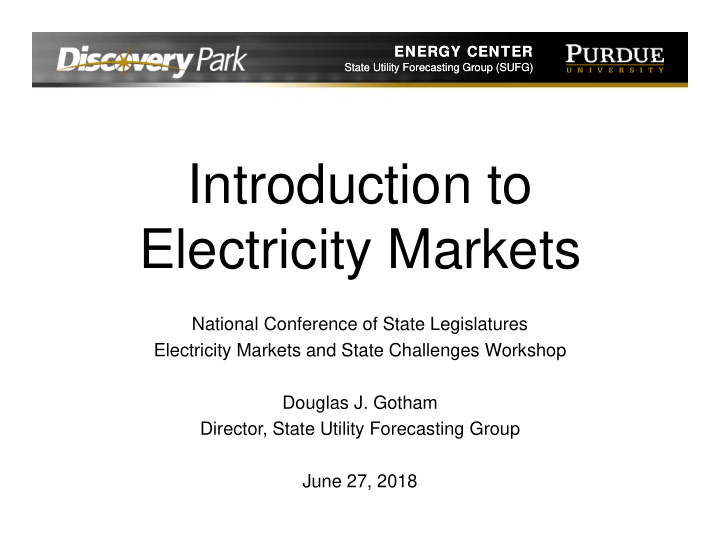



ENERGY CENTER ENERGY CENTER State Utility Forecasting Group (SUFG) State Utility Forecasting Group (SUFG) Introduction to Electricity Markets National Conference of State Legislatures Electricity Markets and State Challenges Workshop Douglas J. Gotham Director, State Utility Forecasting Group June 27, 2018
ENERGY CENTER ENERGY CENTER State Utility Forecasting Group (SUFG) State Utility Forecasting Group (SUFG) State Utility Forecasting Group • Independent research and analysis group at Purdue University • Established by Indiana General Assembly in 1985 • Performs economic and policy analysis, provides assistance to state policymakers 2
ENERGY CENTER ENERGY CENTER State Utility Forecasting Group (SUFG) State Utility Forecasting Group (SUFG) Market Structures • Does the utility operate within a wholesale market operated by a regional transmission organization (RTO) or independent system operator (ISO)? • Is it a traditional vertically-integrated utility or is it under retail choice (aka deregulation)? 3
ENERGY CENTER ENERGY CENTER State Utility Forecasting Group (SUFG) State Utility Forecasting Group (SUFG) RTOs/ISOs 4 Source: Federal Energy Regulatory Commission
ENERGY CENTER ENERGY CENTER State Utility Forecasting Group (SUFG) State Utility Forecasting Group (SUFG) Short-term Energy w/o RTO • Utilities dispatch their own resources to minimize the cost of meeting the load • They may enter into contracts to buy or sell with other entities • They perform both unit commitment (for next day or two) and economic dispatch (now) 5
ENERGY CENTER ENERGY CENTER State Utility Forecasting Group (SUFG) State Utility Forecasting Group (SUFG) Short-term Energy w/ RTO • Suppliers make offers to sell specific amounts of energy at specific prices • Load is also bid at specific prices and quantities • Market operator determines the least- cost method of supplying the load subject to transmission limitations 6
ENERGY CENTER ENERGY CENTER State Utility Forecasting Group (SUFG) State Utility Forecasting Group (SUFG) Locational Marginal Price (LMP) • LMP represents the marginal cost of supplying the last increment of energy to a specific location in the network • Loads pay the LMP for all energy consumed at their point in the network and suppliers are paid the LMP for all energy supplied at their network point • LMPs differ across the network due to transmission limitations (congestion) and losses 7
ENERGY CENTER ENERGY CENTER State Utility Forecasting Group (SUFG) State Utility Forecasting Group (SUFG) MISO LMP Contour Map 8 6/19 3:30 pm 6/20 11:50 am
ENERGY CENTER ENERGY CENTER State Utility Forecasting Group (SUFG) State Utility Forecasting Group (SUFG) Day-ahead & Real-time Markets • RTOs operate a day-ahead market based on expected load and generator availability – settles hourly • Also operate a real-time market to balance deviations from the day-ahead market – load and/or generator availability may be different than expected – settles every five minutes • Both day-ahead and real-time markets determine LMPs at which the market clears 9
ENERGY CENTER ENERGY CENTER State Utility Forecasting Group (SUFG) State Utility Forecasting Group (SUFG) Long-term Planning w/ Vertically Integrated Utilities • Generally under state purview and often done through Integrated Resource Planning (IRP) • IRPs are long-term (10-20 years) studies to determine the appropriate expected mix of future resources (both supply-side and demand-side) • Generally done every 2-3 years • Consider various factors like cost and risk 10
ENERGY CENTER ENERGY CENTER State Utility Forecasting Group (SUFG) State Utility Forecasting Group (SUFG) Long-term Planning w/ Retail Choice • Usually less state overview • Some states may have long-term filing requirements but most do not require IRPs • Suppliers may be subject to RTO capacity requirements 11
ENERGY CENTER ENERGY CENTER State Utility Forecasting Group (SUFG) State Utility Forecasting Group (SUFG) RTO Capacity Markets • Some RTOs have capacity markets that operate 1-3 years in advance to ensure sufficient resources in the future • Load-serving entities must have sufficient resources available to meet their highest level of demand (aka peak demand) plus a reserve margin for unexpected contingencies 12
ENERGY CENTER ENERGY CENTER State Utility Forecasting Group (SUFG) State Utility Forecasting Group (SUFG) RTO Capacity Markets • Capacity prices also serve as an indicator as to when new resources may be needed • Entities in both restructured and traditional states are subject to their RTOs’ capacity requirements 13
ENERGY CENTER ENERGY CENTER State Utility Forecasting Group (SUFG) State Utility Forecasting Group (SUFG) Further Information • Doug Gotham – 765-494-0851 – gotham@purdue.edu • https://www.purdue.edu/discoverypark/sufg/ 14
Recommend
More recommend